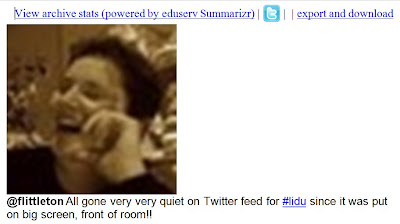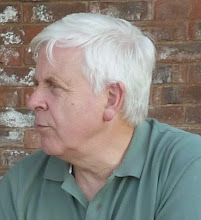I'm going to talk a bit about the LIDU twitter debate at the Society for Research in Higher Education conference next week, so I thought I would revisit it here and create a handy link for myself, for the talk (which makes this post a kind of meta literacy event!).
The twitter debate illustrates the ideological dimension of literacy practices - how communities use them to include or exclude others - so it's quite a good case to use to combat the relentless digital-literacy-as-online-skills discourse that seems to be rather setting the agenda for these kind of discussions at the moment.
I've illustrated it to break up the textiness a bit...
************************************************
It was four o'clock on a sunny autumn afternoon, and the seminar had reached its final plenary session. CJ, in his role as discussant, was summarising the events of the day. Behind him was a large data projection screen. There were about 30 people in the audience, sitting informally in rows. Some of them had notebooks in which they were writing, others were using laptops. Plenty were just listening. It was a typical academic seminar in 'winding-up' mode.
 To illustrate what he was saying about the difficulty of separating technology from practice, CJ projected a view of the live twitter stream to which a few of the audience had been, and were still, posting. The twitter stream remained displayed on the wall behind him while he continued his summary, scrolling occasionally as people in the room continued to post comments.
To illustrate what he was saying about the difficulty of separating technology from practice, CJ projected a view of the live twitter stream to which a few of the audience had been, and were still, posting. The twitter stream remained displayed on the wall behind him while he continued his summary, scrolling occasionally as people in the room continued to post comments.
When the summary had finished, and the audience was invited to respond, a participant said that she felt a surprisingly strong reaction to the the twitter stream (still projected on the wall) which was distracting and intrusive. She felt irritated by the people who were tweeting, as if they were absenting themselves from the live group in order to talk to unseen others.
The tweeters responded that being able to maintain contact with their remote networks enhanced their participation in the seminar. One said that coming from the learning technology world it had not occurred to her that people might object to tweeting, or to the stream being made public.
Others joined in the dispute, but it was relatively mild, nobody punched anyone, and the whole thing was put to rest after about 10 minutes when the projection was switched off and the conversation took another tack. However, most of the tweeting stopped.
Moreover, the episode left its mark on the memories of several of the participants. Feelings were involved: objectors experienced strong negative reactions, some of the tweeters felt got at, exasperated by the objections. Also, the event disrupted the 'knowledge agenda' of the group: a seminar about literacy in the University was forced to see its own practices as problematic, not just those involved in teaching students. The discussion was followed up a few days later on the seminar blog. It was still being referred to 12 months later, in the third seminar, and here am I rehashing it again after two years.
For me it illustrates the ‘ideological’ dimension of literacy as social practice really well. It was an example of contested social action -- a struggle for the legitimacy of a certain kind of text. The twitter stream, both online and as projected onto the wall of the seminar room at this time, is the text – its legitimacy as part of an academic seminar is under attack.
Social literacy has operational, cultural, and critical dimensions. At the operational level there are skills involved in using twitter to communicate. But it isn't inability to use the tool, or to write the kind of things that tweeters write, that causes the non-users to object. They don’t want to use it. I make this rather obvious point to demonstrate the problems of ‘competence deficit' models of literacy. Whilst using twitter may be an aspect of 'digital literacy', not using twitter can’t (yet) be seen as indicative of digital illiteracy.
(It is possible that there are aspects of the operational skill of tweeting which are to do with managing the general communicative context, rather than the specific requirements of the tool, and which might prove taxing for anyone who wasn't practised at it. For example, an engaged tweeter will not only be posting their own comments in parallel with their participation in a face-to-face discussion, they will also be receiving and replying to the comments of others, both present and remote. Multitasking of this kind is characteristic of digital social communication in general and is supposed to be easier for ‘digital natives’ to do successfully, because of personal disposition and, some say, cognitive adaptation (see Prensky and others). But the key word here is 'successfully' because determining what is successful in terms of communication is a cultural as well as an operational matter. In literacy, performance enacts social relations as well as individual skills.
If twittering is seen as a literacy practice for this seminar, it is clear that operational and cultural dimensions are aligned for some participants but not for others. For one participant, prominent as an expert in the learning technology community, there is no reason not to tweet at an academic seminar. For another, recognised as expert in the literacy community, it feels as if people are engaged in private phone conversations with others not present. The management of focus of attention at an academic seminar is a cultural practice that has developed over time. The purpose of maintaining a single focus of attention, as far as possible, is to further the practice of debate, an academic tradition. At one level those who were tweeting could argue that their activities were not undermining debate, but at another level, some of their colleagues clearly did feel undermined - there were other conversations going on, to which they were not party, somehow devaluing the seminar itself as the focus of the discussion.
Both groups in this case seemed to feel that they were being marginalised or otherwise disempowered by the practices of the other. Empowerment and marginalisation are the central 'problem' of literacy at the critical or ideological level.
Both online and face-to-face debate are characteristic of academic discourse around learning technology. But when they happen at the same time participants can come to see others' alignment of operational skills and cultural practice as disruptive or constraining to their own expression. This is fertile ground for the emergence of a critical sensibility, focused firstly on whose practice has appropriated the right to dominate, and then subsequently on how to recognise the rights of all. The critical dimension of literacy is its ideological expression, the manner in which practices function to 'normalise' power relations, including marginalisation, in a social group. Both traditional academic debate, and contemporary social networking, argue for their role as forces for the democratisation of knowledge. However, as we've seen, the practices of each can be perceived as disruptive, or oppressive, by the practitioners of the other. In bringing these (unsuspected, problematic) perceptions into the open and accounting for them through a social theory, such as the theory of literacy as social practice, a larger truth underlying their apparent opposition can be signalled -- the truth that all communication practices privilege some and disadvantage others.
 To illustrate what he was saying about the difficulty of separating technology from practice, CJ projected a view of the live twitter stream to which a few of the audience had been, and were still, posting. The twitter stream remained displayed on the wall behind him while he continued his summary, scrolling occasionally as people in the room continued to post comments.
To illustrate what he was saying about the difficulty of separating technology from practice, CJ projected a view of the live twitter stream to which a few of the audience had been, and were still, posting. The twitter stream remained displayed on the wall behind him while he continued his summary, scrolling occasionally as people in the room continued to post comments.














